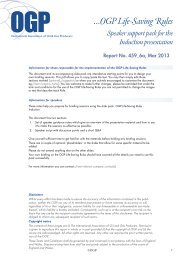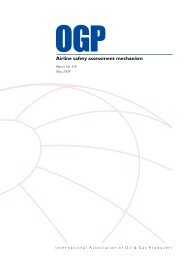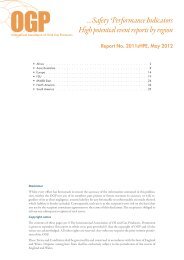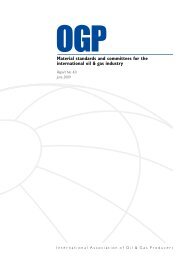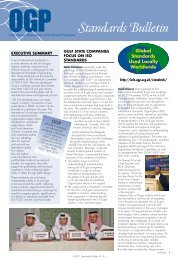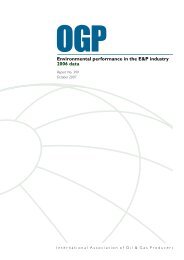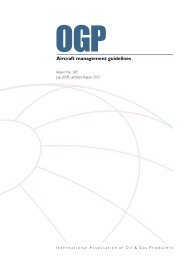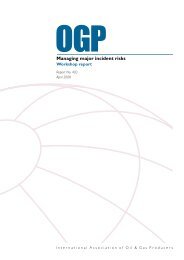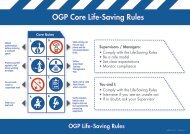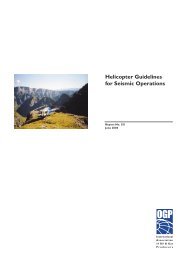Helicopter guidelines for land seismic & helirig operations - OGP
Helicopter guidelines for land seismic & helirig operations - OGP
Helicopter guidelines for land seismic & helirig operations - OGP
Create successful ePaper yourself
Turn your PDF publications into a flip-book with our unique Google optimized e-Paper software.
<strong>Helicopter</strong> <strong>guidelines</strong> <strong>for</strong> <strong>land</strong> <strong>seismic</strong> & <strong>helirig</strong> <strong>operations</strong><br />
e. Covered by a roof or tarpaulin to prevent water ingress in secondary<br />
containment, where appropriate <strong>for</strong> the climate.<br />
f. Be protected from contact with chemicals and not subject to any dying or<br />
painting.<br />
D.4 Drum storage<br />
D.4.1<br />
Storage of helicopter fuel in drums is the least preferred method due to inherent risks<br />
of reduced quality control, fuel contamination and security. Extreme caution should<br />
be used when fuelling from drums due to the possible presence of moisture and/or<br />
sediment. Drum storage and handling should comply with the following:<br />
1. Only epoxy coated steel drums should be used.<br />
2. All drums should be in good condition, sealed at the refinery and with all<br />
required labels and placards attached, including the fill date.<br />
3. All drums will be stored within secondary containment providing full sealing<br />
to avoid small spillage to enter the ground and able to contain the full content<br />
of several drums.<br />
4. Drums will be stored horizontally with the bungs at the 9 and 3 o’clock<br />
positions, with the bung end tilted slightly lower than the opposite end (nonopening),<br />
to prevent moisture/rust <strong>for</strong>mation inside the bung end of the barrel.<br />
5. If exposed to weather and there is a need to have a drums in vertical position<br />
(eg be<strong>for</strong>e use), drums should be kept at a slight tilt to avoid rainwater build-up<br />
within the rim.<br />
6. The drum should have been filled within one-year prior to use.<br />
7. <strong>Helicopter</strong> fuel drums will be stored separately from other types of stock.<br />
8. Provide sufficient supports beneath the first tier of drum stock to prevent the<br />
drums from settling into the soil or resting in water puddles that may cause<br />
corrosion.<br />
9. Chock all drum stocks on both ends of the stack to prevent them from rolling.<br />
10. Contaminated, suspected, or substandard drums will be rejected, labeled<br />
and quarantined separate from acceptable stock and their contents will be<br />
disposed of in an acceptable manner. This will include drums that are used <strong>for</strong><br />
collecting the fuel drained <strong>for</strong> sampling purposes. The standard marking <strong>for</strong> a<br />
contaminated drum is an “X” marked on the bung end.<br />
D.5 Fuel transport to & storage at remote <strong>for</strong>ward staging<br />
points<br />
D.5.1<br />
D.5.2<br />
Where flight <strong>operations</strong> need to be conducted a significant distance from base camp<br />
or other bulk fuel depot, <strong>for</strong>ward staging of fuel can be very efficient in reducing flight<br />
time and hence exposure.<br />
Fuel can be carried to <strong>for</strong>ward staging depots in drums or small (heli-portable)<br />
bladders.<br />
1. Preference is to only use drums as received from the refinery.<br />
2. Re-use of drums will be subject to approval from the local Aviation Advisor.<br />
3. Filling of small bladders or re-used drums should be per<strong>for</strong>med with exactly the<br />
© <strong>OGP</strong><br />
55



